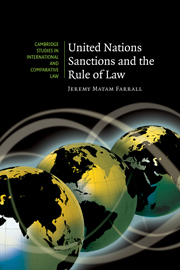Book contents
- Frontmatter
- Contents
- Extended Table of Contents
- Preface
- Abbreviations
- Part I Setting the scene
- 1 Introducing UN sanctions
- 2 Towards a pragmatic rule of law model for UN sanctions
- Part II The evolution of the UN sanctions framework
- Part III UN sanctions in practice
- Part IV Strengthening the rule of law
- Appendix 1 Summary of policy recommendations
- Appendix 2 Summaries of UN sanctions regimes
- Appendix 3 Tables
- Bibliography
- Index
- Cambridge Studies in International and Comparative Law
2 - Towards a pragmatic rule of law model for UN sanctions
Published online by Cambridge University Press: 26 June 2009
- Frontmatter
- Contents
- Extended Table of Contents
- Preface
- Abbreviations
- Part I Setting the scene
- 1 Introducing UN sanctions
- 2 Towards a pragmatic rule of law model for UN sanctions
- Part II The evolution of the UN sanctions framework
- Part III UN sanctions in practice
- Part IV Strengthening the rule of law
- Appendix 1 Summary of policy recommendations
- Appendix 2 Summaries of UN sanctions regimes
- Appendix 3 Tables
- Bibliography
- Index
- Cambridge Studies in International and Comparative Law
Summary
We are here to strengthen and adapt this great institution, forged 55 years ago in the crucible of war, so that it can do what people expect of it in the new era – an era in which the rule of law must prevail.
UN Secretary-General Kofi Annan[W]hile prescribing norms and standards for national or international conduct, the UN Security Council must scrupulously accept those norms for itself.
Prime Minister Rao, of IndiaAt the end of the Cold War, the UN Security Council awoke from its slumber and began to flex its peace and security muscles. The Council had only applied sanctions twice in the forty-five years from 1946 until 1989, but between 1990 and 2006 it established twenty-three new sanctions regimes. The Council also increased its activities exponentially in the field of peacekeeping, creating three times as many peace operations between 1990 and 2006 as it had during the Cold War. In many respects these two boom areas of Council business go hand in hand, as demonstrated by the concurrent existence of a number of peace operations in states subject to sanctions, including Somalia and Haiti in the early 1990s, Sierra Leone at the turn of the century, and Liberia, Côte d'Ivoire and Sudan in the early years of the twenty-first century. Both sanctions and peacekeeping aim to prevent further exacerbation of situations that threaten international peace and security.
- Type
- Chapter
- Information
- United Nations Sanctions and the Rule of Law , pp. 14 - 42Publisher: Cambridge University PressPrint publication year: 2007



